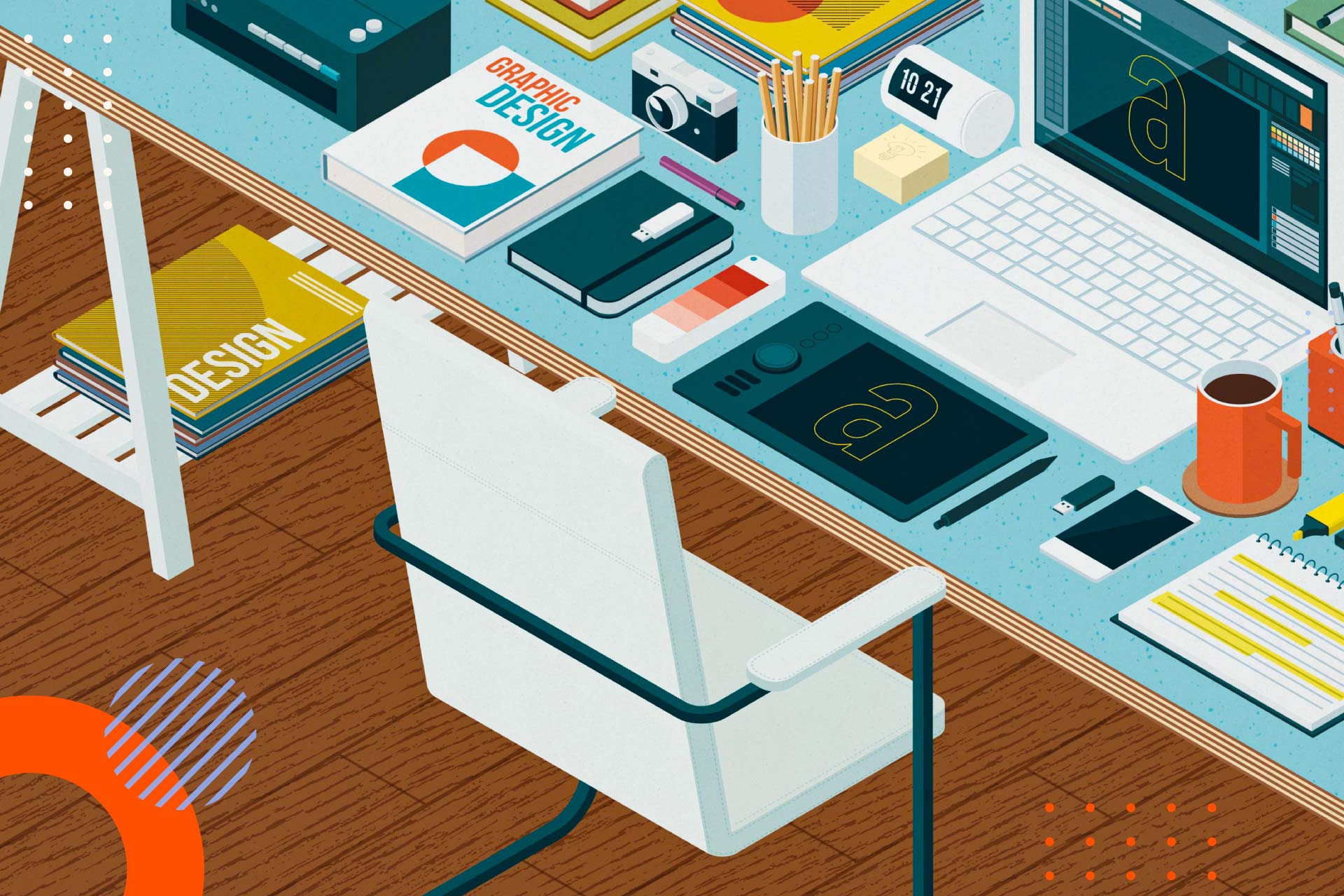Learn Graphic Design Yourself in 2024: Risks and Rewards

Imagine you’re embarking on a new business adventure. Excitement buzzes in the air, and your budget is on a shoestring. Like many budding entrepreneurs, you decide to wear multiple hats—handling everything from web site design and development to customer support. The thought of learning graphic design yourself dances in your mind as a cost-saving endeavor.
In the initial phase, this approach may seem feasible. You’re nimble, overseeing every aspect, ensuring everything is just as you envisioned. However, as your business begins to blossom, spreading yourself too thin can stifle the very growth you’re striving for.
Taking the time to learn graphic design yourself might offer initial cost savings, but it can become a bottleneck as you juggle between various roles. Outsourcing this task to experts, on the other hand, frees up your time, allowing you to focus on strategic decisions and the bigger picture, propelling your business to new heights.
As you ponder over the question, “Should I Really Learn Graphic Design Myself?” consider the long-term impact on your business growth.
Today, we explore the pros and cons of learning graphic design personally, providing insights to inform your decision for your growing enterprise.
Table of Contents
Graphic design transcends mere visual creation. It’s a potent tool for conveying messages, narrating stories, and eliciting emotions. This field elegantly intertwines creativity, technical acumen, and communication skills. The question looming large is: Can one genuinely harness these diverse elements single-handedly?
In this era, the allure of artificial intelligence (A.I.) beckons promisingly to numerous sectors, speeding up processes and executing tasks with remarkable efficiency.
But when it comes to graphic design and particularly good logo design, the human touch remains irreplaceable. A.I. can produce designs, but it lacks the inherent creativity, the understanding of human emotion, and the intuitive grasp of narrative nuance that a human designer brings to the table.
The unique insights, the sparks of creativity, and the deep understanding of your brand’s story and message are aspects that A.I. cannot fully comprehend or replicate.
While A.I. indeed augments and streamlines certain aspects of design, entrusting the entirety of the creative process to it remains a distant reality.
Learning and mastering graphic design personally still hold immense value, affirming the irreplaceable role of human insight and creativity in crafting designs that resonate, communicate, and make a lasting impact.
Pros of Choosing to Learn Graphic Design Yourself
1. Flexibility in Learning
When you choose to learn graphic design yourself, you set your own pace, molding the learning process around your schedule and specific interests.
2. Cost-Effective
Bypass the costs of formal education and harness the power of the internet. There are countless free resources, tutorials, and courses available for those keen to dive in.
3. Real-World Experience
Instead of hypothetical assignments, you can work on real-world projects, building a portfolio over time and adapting to client needs.
Challenges When You Learn Graphic Design Yourself
1. No Structured Curriculum
Without a structured course, there might be gaps in your knowledge, potentially missing out on fundamental design principles.
2. Limited Networking Opportunities
Being a self-taught designer can sometimes mean missing out on valuable classroom connections and being somewhat isolated from the broader design community.
3. Lack of Mentorship and Age Considerations
Without a mentor or teacher, you’re often on your own to seek feedback, which can make the learning curve steep and daunting. Additionally, the challenge of keeping up with swiftly changing design trends, such as the anticipated design trends of 2024, can be overwhelming.
Age can also play a role in this journey. While it’s never too late to learn and grow, older individuals might find the fast-paced world of graphic design technology to be more challenging to keep up with, especially without a mentor to guide them through the latest tools and trends.
This is not to deter older aspiring designers, but it’s crucial to be aware of the additional challenges they might face, and the importance of finding a solid support system or mentorship to navigate the learning process effectively.
4. Innate Talent and Specific Personality Traits
Graphic design is a field where talent greatly matters. It’s not just about knowing the tools and techniques, but also about having an innate sense of aesthetics, balance, and color. A successful graphic designer also needs to be a problem-solver, a good communicator, and have the ability to handle criticism constructively.
Not everyone possesses these traits, and even if one learns the technical skills, the absence of these inherent qualities can hinder the creative process and the effectiveness of the design work.
Resources for Self-Teaching Graphic Design
1. Online Courses & Tutorials
Planning to learn graphic design yourself? Platforms like Udemy, Coursera, and LinkedIn Learning offer courses specifically tailored for self-learners like you, ensuring you get the right knowledge at your pace.
2. Graphic Design Software Tools
As you learn graphic design yourself, it’s crucial to get familiar with essential design tools like Adobe Creative Cloud and Canva. They play a significant role in today’s design world, aiding you in creating stunning designs effortlessly.
3. Books and Magazines
Learn graphic design yourself by diving into classic design texts and cutting-edge publications. These resources provide a wealth of knowledge and insights that are crucial for honing your design skills.
4. Communities and Forums
Be a part of online communities like Behance and Dribbble as you learn graphic design yourself. Engage, seek feedback, and find inspiration from various talented designers worldwide, enhancing your learning journey.
Tips for Aspiring Self-Taught Designers to Learn Graphic Design Yourself Effectively
- Practice Regularly: Embark on the journey to learn graphic design yourself with consistency as your companion. The more you design, the more your skills and understanding expand. Dedicate specific times weekly for practicing design to ensure constant growth as you learn graphic design yourself.
- Seek Feedback and Experience: Gather regular critiques and experiences as crucial pillars in your endeavor to learn graphic design yourself. Offer your design services for free initially to build a strong portfolio and gain real-world experience and diverse feedback. Consider internships or affiliations with a design agency to immerse yourself in a professional environment.
- Stay Updated: Stay up-to-date with the latest trends and techniques as you learn graphic design yourself. Engage with top agencies and participate in online forums to keep your knowledge fresh and relevant, enriching your skills as you continue to learn graphic design yourself.
- Build a Portfolio As you learn graphic design yourself, build a compelling portfolio to showcase your diverse and quality work. A well-crafted portfolio speaks volumes in the design community about your work, dedication, and passion in the graphic design field.
Remember, every professional was once a beginner, and practical experience is invaluable in this ever-evolving industry.
Can I Learn Graphic Design on My Own?
Certainly! While there’s a learning curve, with dedication and the right resources, you can acquire a solid foundation and even master advanced design concepts.
Why Should I Learn Graphic Design Myself Online?
Online platforms offer flexibility and a plethora of resources. You can access top-notch tutorials from anywhere, anytime. Plus, online communities provide a space to share work, get feedback, and connect with peers and professionals.
Why Shouldn’t I Learn Graphic Design Myself Online?
While the digital age empowers us to take on many roles, it’s essential to recognize when to step back and delegate, especially when business growth is at stake. Here’s why self-teaching graphic design might not be the best approach for every entrepreneur or SME owner:
1. The Value of Expertise
As a business owner, your core focus should be on scaling and steering your company’s direction. Diving deep into the intricacies of graphic design might divert your attention from more pressing business matters.
Hiring an expert ensures that your brand’s visual representation is top-notch, reflecting professionalism and resonating with your target audience.
2. The ‘Do-It-All’ Trap
The initial stages of a business often see the owner wearing multiple hats – from marketing to finance. While this can be a valuable learning experience, it’s unsustainable in the long run. Graphic design is a specialized field requiring constant learning and practice.
The time and energy spent here could be invested in strategic business decisions, client meetings, or even work-life balance.
3. The Smart Alternative: Outsourcing to On-Demand Design Agencies
Consider the scenario: learning graphic design from scratch versus having a team of experts at your fingertips, ready to bring your vision to life. An on-demand design agency offers a middle ground between doing it yourself and hiring a full-time designer. They provide expertise, flexibility, and affordability, ensuring your brand gets the attention it deserves without breaking the bank.
With this in mind, it becomes clear that while learning graphic design can be a fulfilling endeavor, it’s crucial to evaluate the opportunity costs.
Would your time be better spent spearheading business strategies and fostering client relationships? Sometimes, letting experts handle specialized tasks is the key to scalable growth.
Should I Enroll in a Full-Time Design Course in School, Online or Part-Time?
This boils down to personal preference, time, and financial considerations. Full-time courses offer structured learning and networking but can be expensive.
Online and part-time courses offer flexibility. Analyze your situation and decide what aligns with your goals.
Not Everyone Can Be a Designer?
As you contemplate whether to learn graphic design yourself, remember that every designer’s journey is unique. Whether you opt for self-education, a full-time course, or services like hire graphic designers from reputable sources, the design world is vast and inviting. It’s a journey of creativity, challenges, and immense satisfaction.
Considering the ever-evolving design world, maybe it’s worth taking the plunge and beginning your design adventure. And if you ever need assistance or a push in the right direction, TripleGrowth are always here to guide and support.
Is it possible to learn graphic design by myself?
Yes, it’s possible to learn graphic design on your own. With numerous online resources, tutorials, and software available, self-learning graphic design has become more accessible. However, the journey may be challenging without structured guidance and feedback.
What are the challenges I might face if I learn graphic design myself?
Learning graphic design yourself can present challenges such as a lack of structured curriculum, limited networking opportunities, absence of mentorship, and staying updated with the latest design trends.
What resources can I use to learn graphic design myself?
Utilize online platforms offering courses, tutorials, and feedback. Books and design blogs can also be beneficial.
Will learning graphic design myself save me money for my business?
Initially, learning graphic design yourself can be cost-effective. However, it might take more time to master the skills needed without professional guidance, impacting your business growth in the long run.
How long will it take to learn graphic design by myself?
The time it takes to learn graphic design yourself varies for each individual. It depends on the time invested and the complexity of the skills you wish to acquire.
How much does it cost for me to learn graphic design myself?
The cost of learning graphic design on your own can vary widely. You may spend from $0 to thousands of dollars. There are numerous free resources online, including tutorials and software, but premium learning platforms and advanced software can come with a significant price tag. The real investment will be your time and commitment.


